Let us start where we must: I do not support violence. I am not here to support or condemn anything, certainly not anything violent. Commentators, especially Western ones, are far too generous with their supports and condemnations. Analysis is difficult enough without peppering it with pompous gestures. And you didn’t come here to read a list of what I support or condemn. I know why you came here, it’s the same reason you always come here, it’s to find out what the hell happened. Let’s go.
[One other note – if the below analysis works for you, it is also the basis for the 2019 book I wrote, Siegebreakers, which, while fictional, is based on research of the military and humanitarian situation in Gaza. Some of you have asked how you could support my work – buying that book and good reviews would be the best way.]
The maps
You know that at the Anti-Empire Project we’re all about the long arc of history. But for the story of the colonization of Palestine going back to the Zionist Congress, the Balfour Declaration, the Arab Revolt, the UN Partition Plan etc., you’ll have to listen to it unfold in World War Civ, probably over the next few years of listening time (as a start you can listen to the story of the Uganda Proposal, when leaders of the Zionist Movement at the beginning of the 20th century were thinking of joining the Scramble for Africa). Instead, here I start with a geopolitical approach and see if we can illuminate a few military issues that are under-emphasized.
The region is mapped nicely by World Atlas. (Map 1)
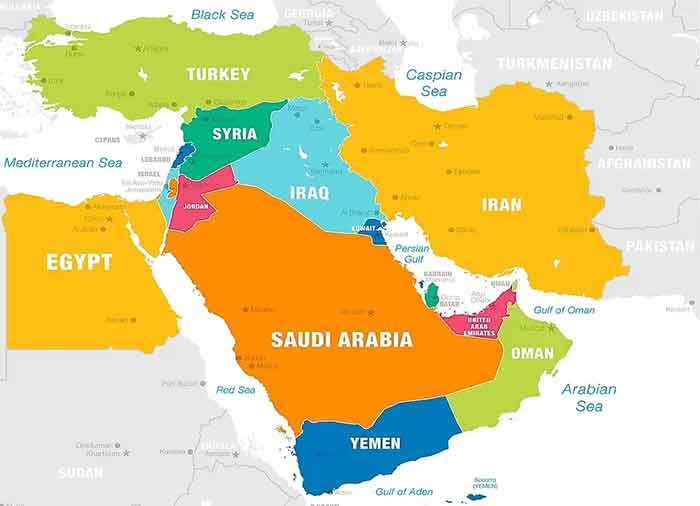
We can zoom in a bit and get a look at Israel/Palestine, the West Bank, Gaza and surroundings courtesy of the BBC (Map 2):
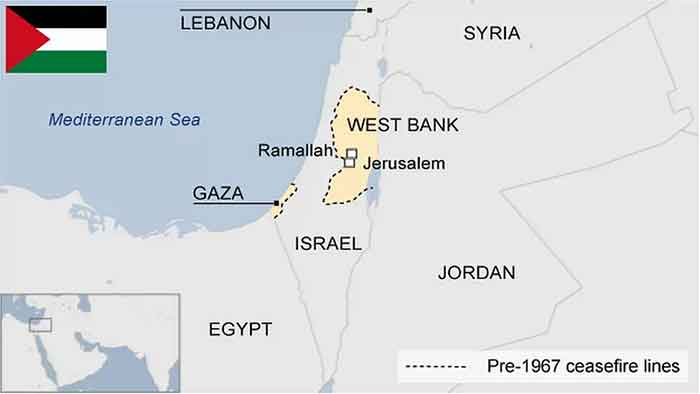
And then, through Wikimedia commons, we can see in Map 3 below the status quo with the apartheid wall and the additional land thefts through 2007 (Israel has stolen more West Bank land since 2007).
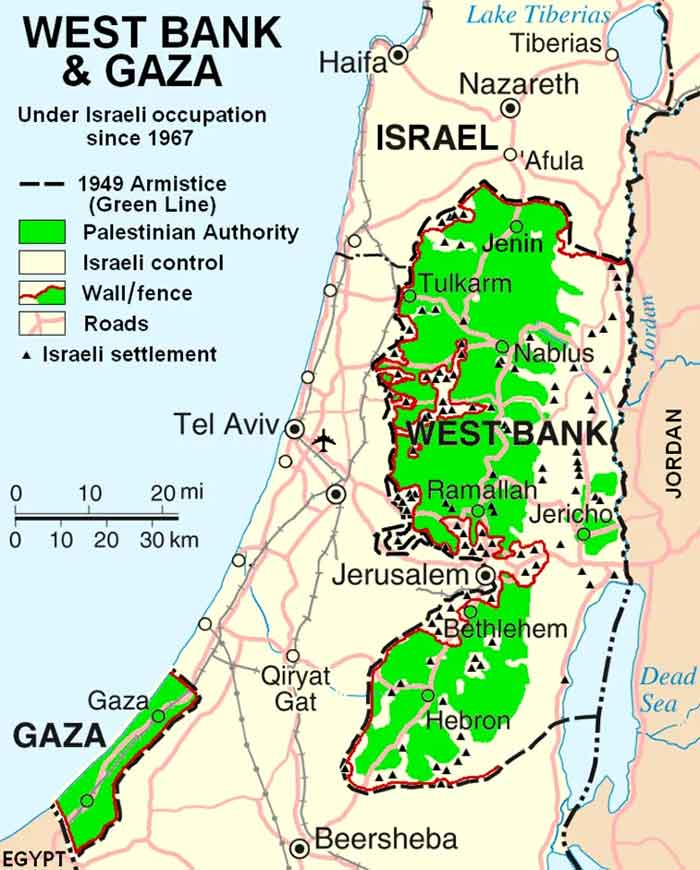
Let’s zoom in one more time, and take a look at Gaza and the surroundings. Both BBC and Al Jazeera have produced “Gaza in Maps” documents recently, from which some important visualizations can be extracted. The BBC version (Map 4) has produced a map of the “evacuation area” that Israel is trying to displace 1 million people from:

Al Jazeera published a helpful map (Map 5) summarizing attacks and the siege by Israel.
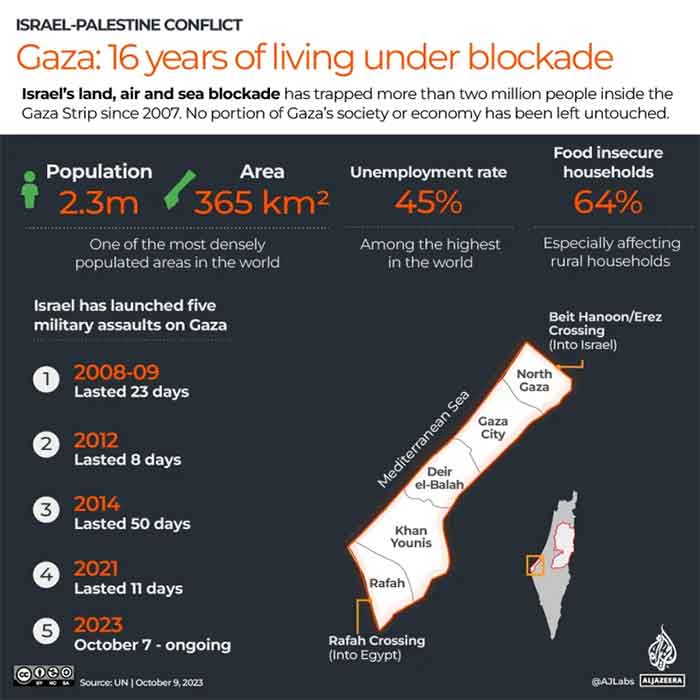
Let us start at the zoom level of maps 4-5 and talk about military affairs on this scale, before zooming back out all the way to the possibility of maybe a world war. We revert to our usual chronological method.
The Chronology
The current, multi-phase conflict began when Israel was created in 1948 and a hundreds of thousands of refugees were displaced by Israel’s military and paramilitary forces into refugee camps in Gaza (and the West Bank, as well as Jordan, Lebanon, Syria, and beyond).
The dynamics changed when Israel occupied the entire Gaza Strip (as well as the West Bank, and the Sinai, since returned to Egypt, and the Golan Heights from Syria, still Israeli-occupied) after the 1967 war, in which Israel defeated Egypt, Syria, and Jordan.
The Palestinian guerrilla struggle was briefly based in Jordan, until the leadership was purged in 1970, when the base moved to Lebanon.
In 1973, Israel fought another war with Egypt and Syria and agreed to give Egypt’s land back in return for a permanent annual bribe from the US. Getting the deal with Egypt, Israel’s giant neighbour, has been key to the US strategy to secure Israel.
Israel attacked Lebanon in 1982 and forced the Palestinian guerrilla movement leaders to leave again (after committing some notable massacres in Sabra and Shatila). The US sent the Marines to separate the warring sides (and de facto support Israel) but the US left after a big bombing by what would become Hezbollah. Syria also intervened in Lebanon in this period. Hezbollah was created out of this 1982 Israeli invasion, and drove the Israeli Army out of Lebanon (almost) entirely in 2000.
Then in 1987-1990 came the First Intifada, a multi-year popular struggle using many of the tools of non-violence including strikes and demonstrations, brave people facing tear gas, beatings, jail terms, and even training and advice from Gene Sharp. Israel responded with a campaign to break the bones of the Palestinians, fill Israeli jails with Palestinian prisoners, and continue the program of illegal settlements.
Several things changed around 1990, marking yet a new phase. The USSR collapsed, and a huge number of Soviet Jews moved to Israel (even though many were pressed to move to Israel and had wanted to go to the US or Germany). The US invaded and destroyed Iraq, disarming it and instituting a devastating sanctions regime. The First Intifada forced Israel to try to negotiate with the Palestinians for the first time. The negotiations succeeded in relieving the pressure on Israel from the Palestinian Intifada.
Brokered by the US, then posing successfully as an honest broker, culminated in the 1993 Oslo Accords, through which the Palestinian Liberation Organization turned into the Palestinian Authority and became a subcontractor of Israel’s occupation of the West Bank, Gaza, and Jerusalem. As Israel continued to expand settlements into occupied territories and encroach on the Al-Aqsa mosque, it became clear that Oslo had been a trap and not the generous offer for lasting peace presented by the honest American broker.
In 2000, the Israeli prime minister invaded al Aqsa with a security escort of 1500 men, sparking the Second Intifada. If in the First Intifada Israel had a policy of breaking bones, the Second Intifada was a military re-invasion of the West Bank and Gaza with snipers, attack helicopters, tanks, and armored personnel carriers. Military checkpoints were set up to cut every Palestinian community off from the others: the Israeli Army used all of the machinery of a modern Western military to suppress a civilian population. When, in 2001, the US declared a War on Terror and invaded first Afghanistan, then Iraq, Israel eagerly joined up, selling its repressive technologies as tested anti-terror weapons in the global arms bazaar as documented in the Israeli film, The Lab (2013).
Until 2005, the West Bank and Gaza shared similar fates: occupied by the Israeli Army, experimented upon for weapons manufacturing and policing/military ideas, their land gradually being stolen by expanding Israeli settlements, an apartheid system of checkpoints and passes.
In 2005, however, Israel withdrew the settlers from Gaza. On the one hand, the departure of an occupying army and colonists is a cause for celebration. On the other hand, Israel had bombed the only airport, controlled the sea, and walled off all the exits. Gaza was a prison. The people who lived there lived under Israel’s control in every aspect. But now that Israel no longer had an interest in settling the land, its military campaigns against the civilian population became ever more unrestrained. Scholar James Ron argued that violence on frontiers was more genocidal than violence in ghettoes. When the Israeli settlers left, Israel was free to unleash frontier-style violence on the imprisoned population.
Under the Oslo Accords there was provision for a Palestinian Legislative Council and the election for that body happened in 2006. There is a lot that could be said about it but for our purposes, let’s summarize it by saying: Hamas won, and they weren’t supposed to. The US and Israel had expected the incumbents (Fatah, whose leaders negotiated Oslo and run the Palestinian Authority as a subcontractor for Israel) to win. When they lost, the US/Israel refused to recognize the winner. Hamas was effectively swept out of the West Bank, which came under Palestinian Authority control. PA forces tried to do the same to Hamas in Gaza, but after a brief armed conflict Hamas ended up on top there.
Hamas was not rewarded for thwarting a coup against it in Gaza: Israel, continuing its relationship with the PA in the West Bank, simply refused to recognize Hamas as the government in Gaza. Instead, Israel besieged Gaza and launched a war in 2006, another in 2008, 2012, 2014, 2018, 2021, and now 2023.
The nature of the Israel-Gaza wars
With our political chronology in hand we are ready to talk about the characteristics of the war between Israel and Gaza – really, I will argue, the conflict between the whole combined West (US, Canada, Europe) and the hitherto stateless Palestinians – but there are some unique elements to the Israel-Gaza part of this bigger war. Who are the combatants, what are their goals, how do they use force to try to attain their objectives in war?
Israel’s objectives. Let us start with Israel, whose leadership has always been transparent about goals and intentions. When these appear unpalatable, they are simply effaced by the West – it is pretended that the utterances were never made. Any historian of the conflict could provide a century of quotes from figures like Chaim Weizmann, David Ben Gurion, Menachem Begin, Golda Meir, Ariel Sharon… but there is no need. The goal was also summarized neatly enough by the current prime minister of Israel when he held up a map of the “New Middle East” at the United Nations in September.

The “New Middle East” has no Palestine and no Palestinians. That is the simple and genocidal objective, announced openly and repeatedly to the world at every turn, most recently in September in this map by the multiply-elected leader of Israel.
[Sure, Netanyahu is unpopular. Many in the leadership think he is corrupt, undermining Israel’s institutions, overreaching, or underreaching. His goal for the “New Middle East” is not unpopular, however.]
Israel’s strategy. The grand strategy of Israel has been, like other settler-colonial states, incrementalism. Constant pressure on the Indigenous population. Constant encroachment. The use of the law to seize land. The assassination of leaders. The imprisonment of leaders. The suppression of cultural expression. Taking control of the means of survival and using that control. As Canada used the famines of the 1880s to force Indigenous peoples in the West onto reserves, at gunpoint and on pain of starvation, Israel uses aid to refugees whose access to land, water, electricity and food have been taken away (when Palestinians build infrastructure Israel bombs it) as a means of control. Periodically, there are crises – wars, uprisings – for Israel these crises are opportunities to increase the quotient of violence and get closer to the exterminist goal.
For Israel’s strategy to succeed there are a number of things that have to go well for them, and these things appear to have been going well for Israel since 1948. These are:
- An unshakeable alliance with the dominant world power, the US (or rather, the US, UK, Europe, Canada, etc.). If US support were to wane for any reason, Israel might be forced to make concessions away from Netanyahu’s map.
- Opponents must be divided with some of them working on Israel’s behalf (the Gulf monarchies, the Islamic State, Egypt, Jordan, the Palestinian Authority) and others mired in internal wars or invaded by the US (Iraq, Syria). Netanyahu’s map can only be made reality if Israel’s neighbours are disunited.
- A “qualitative military advantage” over any of their possible rivals (in the past Jordan, Egypt and Iraq, notably Syria, in recent decades Hizbollah and Iran, and of course the Palestinians). Without military superiority, Netanyahu’s map remains a colonizer’s dream.
Addressing each of these in turn. 1. About Israel’s ability to maintain Western support regardless of what its actions are, Netanyahu is a particularly confident leader. He has been recorded bragging about having the US leadership in his pocket, the recordings made public, etc. Despite now decades-old predictions that US youth would abandon Israel (e.g. Norman Finkelstein’s 2012 book, Knowing Too Much, that focused on idea that the US Jewish community would grow disillusioned with Israel) the solidarity of the elite of all Western countries with Israel is complete. Rooted as it is in racism and colonialism, Western elite solidarity with Israel will not be dislodged. As Israel drops 1000 bombs a day, cuts water, food and electricity to Gaza, calls the people “human animals”, etc., the solidarity remains unbroken – Western politicians focus on gestures of support for Israel and persecution of pro-Palestine sentiment in the West. Nor can that solidarity be cracked by a Palestinian nonviolent movement, as some fantasized it might be. In 2018, hundreds of Palestinians were shot to death like fish in a barrel by Israeli snipers as they engaged in a massive nonviolent struggle. Western hearts were not melted. The West was unmoved. Western solidarity with Israel is solidarity unto genocide, at least at the elite level. More on this question, below.
2. Egypt’s military regime continues to co-operate with Israel no matter what Israel does to Gaza. Despite its vast size (population 112 million) and its near-victory in the 1973 war, since the 1970s Egypt is in a position where the US and Israel exert immense influence over it (with debts to the IMF, a lack of food sovereignty, etc.). The Palestinian Authority, whose leader once described their security agreement with Israel as “sacred”, continues to seem impossible to dislodge, despite its unpopularity, even as it works to keep the West Bank divided and caged. More geographically distant states like Turkey have expressed disapproval, but such disapproval seems toothless at the moment. Turkey sent thousands of tons of tomatoes to Israel to help replace the tomatoes lost in the warfare around Gaza.
3. The question of Israel’s “qualitative military advantage” remains the great unknown. The two opponents that Israel has fought wars with in recent decades are Hizbollah in Lebanon and the Resistance in Gaza (it’s not correct to call it “Hamas”, because Hamas is a political party with an armed wing called the Izaddin al-Qassam Brigades, but there are other armed groups affiliated with other political parties and there is always an alliance of military resistance factions from different political parties arrayed against Israel).
Taking Lebanon first: Israel invaded Lebanon in 2006 and bombarded the country from the air, claiming to have the objective of destroying Hizbollah, who responded by launching missiles of their own into Israel and repelling the ground attack. Lebanon was devastated, but Hizbollah was not destroyed and continued to build their military capacities. Presumably, both sides have studied and tried to learn lessons from the 2006 war, so no one knows how the next war between these belligerents would go. Since 2006, Hizbollah has sent forces to support the Syrian state in the civil war, which presumably involved both taking mass casualties and also gaining experience and developing new abilities. Israel, since 2006, has fought all of its wars with Gaza.
As mentioned above, Israel has fought nearly annual wars against Gaza: 2006, 2008, 2012, 2014, 2018, 2021, and now 2023. There were ground invasions in 2008, 2012, 2014, and 2018, but the ground invasion of 2014 was also a frightening experience for the Israeli military, which has focused since on using the air force to bomb civilian targets.
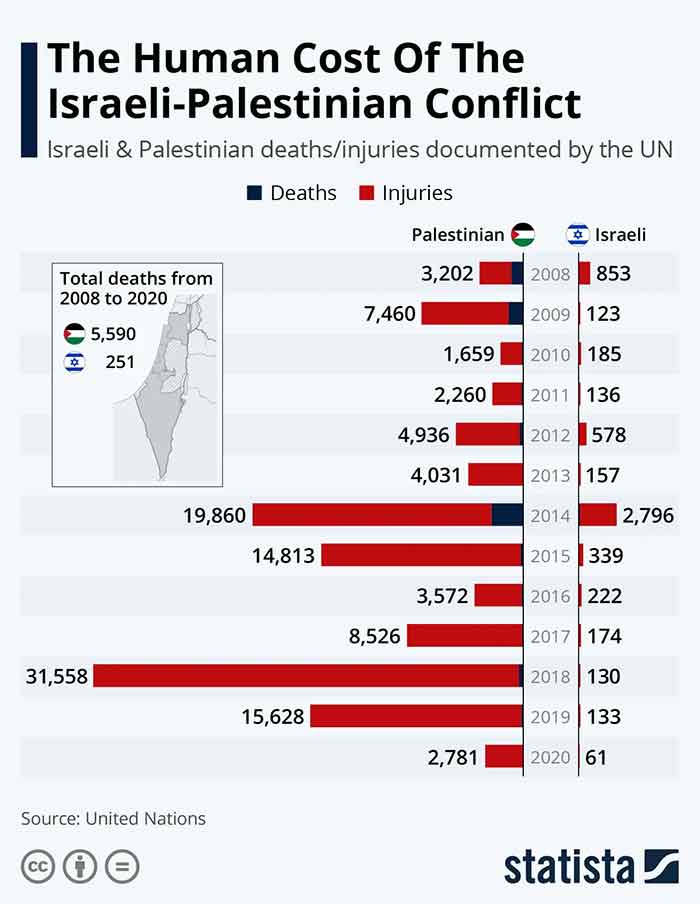
Because Gaza is sealed, the Gaza Resistance launches rockets into Israel to answer the Israeli air force’s bombings. Israel’s bombs have much bigger payloads of explosives than the Gaza Resistance’s rockets, and Israel has progressively destroyed more and more of Gaza’s civilian infrastructure. Having destroyed more of the infrastructure, Israel tightens the siege (and in the current conflict, the siege is total, no water, electricity, or food allowed, and as mentioned before an ongoing negotiation to use food and water to force Palestinians in Gaza to accept displacement from their homes – per Netanyahu’s map). Israeli’s long-running goal is to push the people of Gaza into the Sinai desert and annex them. Having failed to do so by invasion, Israel is now trying to do it through a combination of imposed famine and aerial bombardment.
[What? Surely if Israel has humanitarian concern for the Palestinian population, if the real problem is Hamas, then Israel ought to take in those Palestinian refugees within its own borders? Rhetorical question, obviously.]
Can the Gaza Resistance break this pattern? Let us turn to that side.
Palestinian Resistance objectives: Settler states are “negationist” toward Indigenous people and Israel’s position toward any resistance leadership Palestinians have is that those leaders must be killed or jailed before Israel is willing to talk. This was the case with the Palestinian Liberation Organization from the 1960s, and it is the case with the Palestinian Resistance today, which is today summarized with the word “Hamas”, and then conflated with the actions of the Islamic State in Syria, widely believed to be a US proxy whose goal (shared with the US and Israel) was to overthrow the government of that country. When an errant ISIS shell landed in Israel, the Islamic State apologized. On the other side, Israel assisted ISIS fighters during their war on the Syrian state. So when pro-Israel people say Hamas needs to be treated like ISIS, they don’t mean treated the way Israel treated ISIS, which was to assist their fighters and try to keep them going. Likewise, the notion that “Hamas” just wants to “kill Jews” is racist nonsense – part of the genocidal campaign against Palestinians and of colonial negation of Indigenous leaders.

No, Palestinian Resistance is not a nihilistic US proxy like ISIS. Its objectives are much simpler: to stop the theft of their lands and the genocide of their people, to secure their rights, including to return to the homes they were displaced from, and to secure their holy places (especially the al-Aqsa mosque in Jerusalem) against Israel’s plan to destroy it (like India destroyed the Babri mosque in 1992).
Palestinian Resistance Strategies. From the beginning of the Second Intifada in 2000 to the completion of the Apartheid Wall in 2005, the Palestinian Resistance used many civil resistance strategies throughout Gaza and the West Bank, including nonviolent protests and strikes. These were unsuccessful in the face of the increasingly heavy weapons brought to bear: as I mentioned above, Israel used tanks, attack helicopters, snipers, and aerial bombardment against civilians and assassination, imprisonment, and torture as responses to Palestinian political struggle.
Some Palestinian factions used “terrorist” methods, including bombings on buses (an interesting and dispassionate analysis, to the extent such a thing is possible, of “suicide terrorism” can be found in Robert Pape’s book, Dying to Win). Once the settlers left Gaza and especially once Hamas became the government there, the Resistance basically abandoned suicide bombing as a tactic. Instead, the Palestinian Resistance followed a similar evolution by Hizbollah from its inception in the 1980s and early “terrorist” methods. Like Hizbollah did gradually from the 1980s and facing the same opponent, the Palestinian Resistance from 2005 on focused on the slow construction of a conventional, professional military force to fight the Israeli military. To answer Israel’s aerial bombardment of Gaza, the Resistance worked on developing rockets, gradually improving their range and explosive power. In early conflicts they carried very small payloads and did very little damage, but their capacities have grown with each conflict. As Jon Elmer reported in 2012:
[Qassam] “was Gaza’s smaller-scale answer to Hezbollah, led by Qassam Brigades commander, Ahmed Jabari. Under Jabari, Hamas’ armed wing transformed into a more structured and professionalised force. “This isn’t a terror organisation anymore,” said Minister for Home Front Defence Avi Dichter, two days before Jabari’s assassination, “it’s a bona fide army.”
On the other hand, to protect against an Israeli re-invasion of Gaza and the re-introduction of Israeli settlers and colonies, the Palestinian Resistance developed a ground force specializing in urban warfare, with a tunnel network that the Resistance could use in the event of such an invasion.
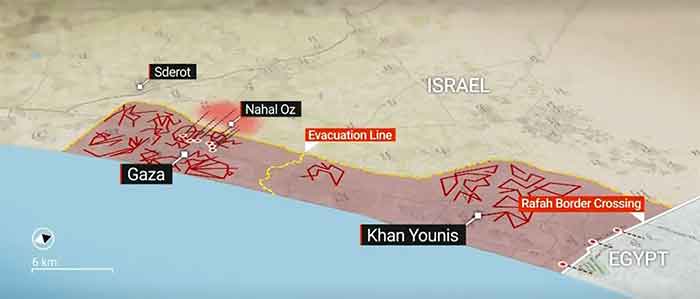
Resistance ground forces defeated Israeli troops in several major ambushes during Israel’s 2014 invasion of Gaza, as documented in Max Blumenthal’s book The 51-Day War; in the face of these ambushes, Israeli troops would withdraw and engage their air force to destroy the entire neighbourhood where the ambush occurred.
On the character of the October 7 attack. Much of what happened on the ground in the October 7 attack by the Palestinian Resistance in the so-called “Gaza Envelope” will remain unknown until both sides release the full details from their perspectives to be compared. Some of what is known is that Palestinian Resistance forces attacked settlements outside Gaza, including military bases and posts, captured military personnel, and returned inside the fence. The fighting continued for days in some places.
The military objective as outlined in the communications by Resistance spokespeople was to break out of Gaza and to take prisoners of war who could be exchanged for the thousands of Palestinian political prisoners held in Israeli prisons. Israel’s countermove appears to be to unleash a genocidal aerial campaign and starvation to try to push the entire population of Gaza south, ideally into tent cities in Egypt. Military objectives were attacked, military equipment was destroyed and military personnel were taken prisoner. Hamas official spokesperson has said that all civilians, beginning with those who were not Israeli, would be returned unconditionally, while Israeli military prisoners would be exchanged for the thousands of Palestinians held in Israeli prisons.
Israeli sources reported that many civilians were killed and captured during the attack, in addition to hundreds of Israeli military personnel. According to a pre-recorded Hamas press conference, Resistance forces were given strict orders to engage military and police and not to attack civilians. They attribute the violence against Israeli civilians to people outside the professionalized Palestinian Resistance forces who escaped from Gaza once the fence was breached and the Israeli forces keeping the Palestinians encaged were occupied in gun battles with the Resistance. There were also civilians who were killed when caught between the Resistance and Israeli forces as they engaged one another in combat. Atrocities have been reported by the Israeli military and picked up by the Western media.
An accepted account of the extent of these atrocities, their perpetrators, and all the details that both sides agree upon will eventually come out. At the moment, stories of terrible atrocities committed by the Palestinian Resistance (“Hamas”) on October 7 are the principal rhetorical weapon wielded by Israel’s supporters in justifying every Israeli act, from imposing dehydration and soon, famine, to bombing sites like churches and hospitals where refugees have gathered in large numbers after their houses have been reduced to rubble by previous bombings. Given the function of these atrocity stories in the current moment of genocide, and the systematic lying by the Israeli military and by Western sources about the conflict, claims sourced from the Israeli military have to be treated with extreme skepticism.
In any case, a military impasse has persisted since 2014, and appears to persist even now, as Israeli troops threaten a ground invasion but in practice continue to kill civilians from the air, bombing thousands of civilian targets a day including increasingly outright civilian and refugee gathering places in a genocidal pattern, rather than engage Palestinian Resistance forces on the ground where they might take even higher military casualties.
The genocide-in-motion will force the region to react.
It’s time to zoom out all the way to Map 1.
The regional war context
During the Syrian Civil War, perhaps before, the concept of the “Resistance Axis” was coined. The Resistance axis includes Iran, Hizbollah, Syria, Ansarallah in Yemen (the so-called Houthis), and armed groups in Iraq as well. The Palestinian Resistance, including Hamas, are considered part of the Resistance axis today (this was not always the case, for reasons I won’t get into here but may have occasion to discuss in future).
Israel’s genocidal campaign in Gaza is enraging the Resistance axis, as are Israel’s ongoing encroachments and planned partition (and destruction) of the al-Aqsa mosque. Conflict between Israel and Hizbollah on the Lebanese border has been slowly ticking up. There are reports that on October 19, the day after Israel bombed the Ahli hospital and killed 500+ people in a single attack, Ansarallah launched a missile from Yemen that was intercepted by the US Navy and an Iraqi resistance group launched a drone attack on a US base in Iraq. Iran’s Foreign Minister has stated that Iran will intervene if the attack continues.
If Hizbollah joins the war, Israel’s air force will try to destroy Lebanon’s cities once again, but Hizbollah has more powerful missiles than it did in 2006 and it has the combat experience of Syria behind it. Presumably Israel has also prepared for a new war with Hizbollah and the US may join as well.
If Iran joins the war, the US would join as well, and we will be in fairly new situation in terms of the scale of the war, the weapons available to the combatants, and the effects on the global economy starting with the global energy system. I would rather not talk about it or even think about it until I have to, so let’s leave it there for now.
Extreme Western solidarity – and its possible cost
The Western response to Israel’s genocidal campaign has been a change from the past. In all previous Israeli campaigns against Gaza (and Lebanon) since 2005, different Western countries offered slightly different variations of support for Israel combined with calls for peace or for a ceasefire. This round, however, all Western countries spoke with one voice to repeat the mantra that Israel had the right to do whatever it wanted, it needed to explain nothing to anyone, and all that was required of Palestinians was to renounce terror and die. Supporters of Palestine in the West were subject to aggressive libels (this will need its own newsletter or series, stay tuned). France’s top court banned pro-Palestine protests (people came out in huge numbers anyway). Berlin banned pro-Palestine protests (including by a Jewish group). A UK official said waving the Palestinian flag might be a criminal offense.
Why the extreme Western solidarity with Israel this time? Why the extra virulence of anti-Palestinian racism? Western officials explain it in terms of the heinousness of the attack into the ‘Gaza Envelope’ by the Resistance, but Israel’s atrocities have already topped even the maximalist death tolls that Israel gave for October 7th.
Western officials can commit, and tolerate, the deaths of millions (they did in the War on Terror in Iraq, Afghanistan, Yemen and elsewhere) without batting an eye. Sincere moral indignation cannot explain it, since Western elites don’t possess it.
Instead, the West is showing loyalty and demanding loyalty to Israel in proportion to the monstrosity of Israel’s crimes. To support genocide – that is the biggest test of loyalty imaginable.
The price for Western leaders of taking this stance, still to be determined, will be paid in the repulsion of people of the global south, sometimes quantified as “soft power” or “global prestige”. No Western country can pretend to be an “honest broker” again, no Western country can be taken seriously when talking about human rights, international law, or nonviolence. The price is already being paid. When Blinken went to the Middle East, Jordan didn’t receive him, the head of the Palestinian Authority cancelled their meeting after the hospital bombing, the Saudi monarch made him wait multiple hours before postponing. The US ambassador to the UN Human Rights Council found people getting up and turning their backs during her speech. Canada’s prime minister was booed when trying to get a photo op at a Toronto mosque.
If Westerners were so ready to abandon it, how valuable was this liberal order? How valuable was this soft power? Can it be restored after the UK prime minister, the EU Minister, and the US president all fell over themselves to visit Israel during the genocide? Perhaps it will. Perhaps the West is as indispensable as these leaders believe and these frayed relations can be patched up once this round ends, as they have been in all the previous rounds. This particular issue will take time to settle.
How this round ends
How then, will this particular round of conflict end? There are a limited set of possibilities.
1- Total victory for Israel; Genocide; Rolls into regional, maybe world war. Even if, as one Israeli official projected, Israel kills 600,000 Palestinians this round, this problem will persist. Even if Israel and the West successfully use famine to sweep the people of Gaza into the Sinai desert, it will not be secure in its new border and the new rubble-covered buffer zone it has created.
There are two reasons for this: the first, because all of Israel’s neighbours understand that they are next, and the regional war will keep ramping up as the genocide continues. Israel wants to do it, and the West would allow it, but the Resistance Axis would not, so even a genocide isn’t the end of the story.
The second, because one of the pathologies of settler-colonies is that they are obsessed with Indigenous people. Israel could no more leave 2 million Palestinians in Sinai alone than they could leave the Palestinians in Gaza, the West Bank, or Jerusalem alone. The idea that settlers want land and want to get rid of Indigenous people is only partly true: settler-colonialism is a constant process of displacement, confinement, humiliation, cultural appropriation and ultimately, identity formation. Only decolonization can heal this pathology whereby the settler defines his identity against the Indigenous person.
2- Ceasefire. Awaits the next round. Could this round end as previous rounds have, with a unilateral ceasefire declared by Israel? A protracted negotiation and prisoner exchange? Israel remaining in control of water, food, and electricity, inspecting food items that come in through Rafah? Gaza that much more devastated, thousands or tens of thousands more killed? It could. That status quo would hold until the next big operation by the Resistance, at which point the cycle would repeat. With the scale of what Israel is doing now, this doesn’t look like the most likely possibility, but it has certainly happened before and could happen again.
3 – Resistance victory. Gaza siege broken. Three years ago, Iran, under US sanction, sent an oil tanker to Venezuela, also under US sanction. People from both countries (and many others) watched the progress of the tanker on the web and wondered whether the US was going to start a naval battle and a war. The tanker got through, and it was the first of many.

When the siege on Gaza is finally broken, it will probably be by an Iranian cargo ship sailing in. At the moment, that particular path to ending the siege is blocked by three US aircraft carrier groups.
There may be others I have missed. But likely it will be some combination of these three that plays out over the medium term.
Rebuilding after genocide
We cannot know how far the genocide will go and we have a very small room to maneuver to try to work toward stopping it. I told you at the beginning I’m not here to support or condemn but I am anti-genocide, it remains a durable political commitment of mine.
In the long term, Palestine will recover as others have. Vietnam, where the US killed 2-5 million people, is thriving today. More recently, the genocidal war on Yemen led by Saudi Arabia and with full US and UK (and Canadian etc.) participation, started in 2015, is now basically over, in what looks like a permanent ceasefire mode. There, too, there was a famine created by a blockade, uncounted dead, tens of thousands of whom were children. The people of Yemen suffered immensely, and for a long time it seemed hopeless – the idea that Yemen could answer the far greater weaponry and resources of fully Western-backed Saudi Arabia seemed far-fetched. Today the pro-Palestine demonstrations in Yemen are some of the biggest in the world (they always were).
Palestine also won’t be defeated.
Justin Podur is a Toronto-based writer. You can find him on his website at podur.org and on Twitter @justinpodur. He teaches at York University in the Faculty of Environmental and Urban Change.
Originally published in The Anti-Empire Project








































